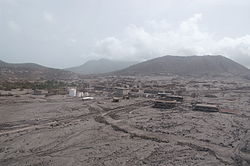Plymouth, Montserrat
| Plymouth | |
| Montserrat | |
|---|---|
 Plymouth, abandoned | |
| Location | |
| Data | |
| Population: | 0 |
| Local Government | |
| Council: | Parish of St Anthony |
Plymouth was the capital of the island of Montserrat, a British overseas territory, until it was overwhelmed by volcanic eruptions starting in the 1990s and was abandoned in advance of its final destruction by the volcano. It is found on the south-west coast of the island.
For centuries Plymouth had been the only port of entry to Montserrat, and the loss of the town has required a major restructuring of the infrastructure and life of the island. The site of Plymouth is now within the Exclusion Zone in which living and working is forbidden.
Volcano and abandonment
Beginning in July 1995, a series of huge eruptions at the Soufrière Hills volcano sent pyroclastic flows and ash falls across a wide area of southern Montserrat, including Plymouth. It was immediately clear that the city was in danger and on 21 August 1995, tephra fell on Plymouth, and in December residents were evacuated as a precaution.
Residents were allowed back a few months later, but on 25 June 1997, a massive eruption produced pyroclastic surges that killed 19 people and reached nearly to the island's airport on the eastern side of the island. Plymouth was again evacuated.
Between 4–8 August a further series of eruptions destroyed approximately 80% of the city, burying it under 4.6 feet of ash. This hot material burned many of the buildings, making inhabitation nearly impossible for a sizable portion of the residents.
The pyroclastic flows, lava, ash and other volcanic rock types were mostly compact, having a density similar to that of concrete. The removal of the overburden would have required the use of explosives, bulldozers and other resources too expensive for widespread use. Furthermore, it was anticipated that the soil underneath the hardened mud and lava would have been scorched and left completely barren by the heat of the pyroclastic flows. Plymouth was abandoned and the southern half of the island was declared an "exclusion zone" because of the continuing activity at the Soufrière Hills. The government of the island was moved to Brades. As of 2013, a new port and capital are under construction at Little Bay, on the island's north-west coast.
The destruction of Plymouth caused severe problems for the island of Montserrat. Plymouth had been by far the largest settlement on the island, with around 4,000 inhabitants. It had been the site of almost all the island's shops and services, in addition to having been its seat of government. Some of the lost facilities were subsequently re-built elsewhere on Montserrat, but this did not prevent emigration. More than two-thirds of the island's population was evacuated overseas, and most of the people who left have not returned.
Outside links
| ("Wikimedia Commons" has material about Plymouth, Montserrat) |


